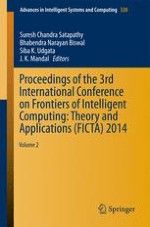2015 | Buch
Proceedings of the 3rd International Conference on Frontiers of Intelligent Computing: Theory and Applications (FICTA) 2014
Volume 2
herausgegeben von: Suresh Chandra Satapathy, Bhabendra Narayan Biswal, Siba K. Udgata, J. K. Mandal
Verlag: Springer International Publishing
Buchreihe : Advances in Intelligent Systems and Computing
